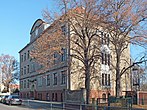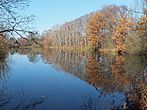Knautkleeberg
|
Knautkleeberg district of Leipzig |
|
|---|---|
| Coordinates | 51 ° 16 ′ 57 " N , 12 ° 18 ′ 47" E |
| height | 118 m |
| Incorporation | 1930 |
| Post Code | 04249 |
| prefix | 0341 |
| Borough | southwest |
| Transport links | |
| railroad | Railway line Leipzig – Probstzella |
| tram | 3 |
| bus | 63, 120, (118) |
Knautkleeberg is a district of Leipzig . Together with Knauthain, Knautkleeberg forms the administrative district of Knautkleeberg-Knauthain in the south-west of the city. Until it was incorporated into Leipzig in 1930, Knautkleeberg was an independent municipality. Together with Knautnaundorf , the two former villages are called Knautdörfer .
Location and local characteristics
Knautkleeberg is located in the southwest of Leipzig, about eight kilometers from the city center. It is the first of the south-western parts of the city that can be reached behind a development gap south of Großzschocher and that is called “behind the poplars”. Knautkleeberg lies on the western edge of the Elsteraue. The Knauthainer Elstermühlgraben runs right on the outskirts , a little to the east the White Elster . The Naturbad Südwest , a former gravel pit, extends between Windorf and Knautkleeberg .
The neighboring districts of Knautkleeberg are from the north clockwise Großzschocher, Windorf , Knauthain, Rehbach and the Mark Flickert . The current administrative Knautkleeberg essentially coincides with the historical district Knautkleeberg except for the part of Rehbacher Straße west of the railway line and the subsequent Anersiedlung, which are located on the former Knauthainer Flur.
Knautkleeberg is a purely residential area with buildings from different eras. Some properties around the old village center near the former mill still point to the village past. In addition to urban tenement houses from the beginning of the 20th century, there are also numerous villas from this period that document the wealthy Leipzig residents' urge to go green. But also after 1990 numerous single-family houses were built, not least because of the natural location of the place to the meadow landscape and the Cospudener See . In 2012 the mill complex, which had been closed since the 1990s, was converted into a residential complex with 27 apartments.
traffic
The only road leading directly from the core area from Leipzig to Knautkleeberg is Dieskaustraße. The LVB tram line 3 provides the public transport connection to the city center via this and in some parts on independently routed tracks . At the end of the tram there is a connection to bus routes 63 to Hartmannsdorf, 120 to Kitzen , Großdalzig and Zwenkau and the seasonal route 118 to the Belantis amusement park . In 2009 the previous triangle of the tram terminus with the arrival track in Gleitsmannstraße was replaced by a turning loop, creating a common transfer point between railroad, tram and bus, which is sometimes praised as the “gateway to the south”.
The train station for the Leipzig – Gera railway line is in the immediate vicinity of the tram terminus . Trains of the Erfurter Bahn GmbH stop there every hour . The curious situation arises here that the train station, which is actually located on Knautkleeberger Flur, is still called Leipzig-Knauthain, due to the influence of the Knauthain manor owner at the time, while the terminus of the tram, which after its renovation in 2009 is now even partially on Knauthainer Flur , continues to bear the traditional name Knautkleeberg.
history
Knautkleeberg was first mentioned in 1190 as Cleberg. It was one of the villages that were owned by the Knaut family in the 11th century . The complex as a Gassendorf on today's Seumestrasse and the German name indicate a German foundation. As early as the 12th century, the Mühlgraben was created at the instigation of Wiprecht von Groitzsch and under the direction of the monks of the Pegau monastery . In 1497 a forework of the Knauthain manor with a mill is mentioned for the village. In 1551 there were 32 farms in the village.
During the Thirty Years' War the place was destroyed and the population decreased. The latter was also due to a plague epidemic in 1642, because of which even a bypass was established for long-distance traffic. From 1696 the village belonged to Gut Lauer to the east and was first called "Knaut-Kleebergk".
In 1770 Andreas Seume, the father of the poet Johann Gottfried Seume , leased the inn "Zum Weißen Roß" in Knautkleeberg, as the poet later reported. The house was demolished in 1980. Seume spent his childhood in Knautkleeberg and, since Knautkleeberg had neither a church nor a school, attended the school in Knauthain. It was not until 1908 that Knautkleeberg received its own school, which celebrated its 100th anniversary and is still used today as the 60th elementary school.
In 1775, like the neighboring villages, Knautkleeberg came into the possession of the von Hohenthal family . Until 1856 Knautkleeberg belonged to the electoral or royal Saxon district office of Leipzig . In 1856 the patrimonial jurisdiction was abolished and the village got more and more rights of its own. From the second half of the 19th century the infrastructure also improved: 1873 rail connection, 1899 gas supply, 1908 connection to the Großzschocher / Windorf water supply system, electricity connection completed by 1914 and all roads paved. These circumstances and the beautiful landscape prompted many wealthy Leipzigers to build their country houses or villas here, so that Knautkleeberg and Knauthain grew together structurally. But rental apartments with an urban character also emerged. The population grew from 344 in 1871 to 2329 in 1910.
As early as 1860, a brick factory was working in Knautkleeberg, which left ponds in the floodplain after the clay had been extracted. Fortunabad was built here by the community in 1920, which decayed after the Second World War and which is only reminiscent of beautiful water surfaces.
At the end of the 1920s, many landowners sold their land as building land, and new settlements were built, now also west of the railway line, such as the Albersdorfer settlement, the pond settlement, the settlement on Wildentensteig and on Nimrodstrasse. In 1930 a bus line was set up from Großzschocher and in 1935 the tram line from Großzschocher to Knautkleeberg was extended.
On April 1, 1930 Knautkleeberg was incorporated into Leipzig. According to the municipal reorganization of Leipzig in 1992, Knautkleeberg and Knauthain formed the district of Knauthain-Knautkleeberg. Hartmannsdorf was added in 1993 and the district was now called Knauthain-Hartmannsdorf. In 2001 the old district was restored, but now with the name Knautkleeberg-Knauthain.
See also
Individual evidence
- ↑ LVZ article as pdf
- ↑ Knauthain becomes "Gateway to the South" ( page no longer available , search in web archives ) Info: The link was automatically marked as defective. Please check the link according to the instructions and then remove this notice. In: Leipziger Volkszeitung via ZVNL , June 1, 2010.
- ↑ Johann Gottfried Seume: My Life (online at Zeno)
- ↑ Georg Meyer-Thurnow documents in Leipziger Blätter No. 61, 2012, p. 40 that Seeumes father did not enter himself into the Knautkleeberg property register until 1771.
- ^ Karlheinz Blaschke , Uwe Ulrich Jäschke : Kursächsischer Ämteratlas. Leipzig 2009, ISBN 978-3-937386-14-0 ; P. 60 f.
- ↑ Knauthain-Knautkleeberg in the Leipzig Lexicon
literature
- ProLeipzig eV (Ed.): In the Leipziger Elsterland from Plagwitz to Hartmannsdorf . PRO LEIPZIG 1997, ISBN 3-9805368-3-1 , pp. 153-160
- Thomas Nabert (Red.): Behind the poplars. Stories from Knauthain, Knautkleeberg, Hartmannsdorf, Rehbach and Knautnaundorf , Volume 1–3 ProLeipzig 2002–2004
- Jörg Loos, Jens Geßner: Knauthain and Knautkleeberg . In: Leipziger Blätter No. 17, 1990, pp. 84-86
- Knautkleeberg . In: August Schumann : Complete State, Post and Newspaper Lexicon of Saxony. 4th volume. Schumann, Zwickau 1817, p. 730.
- Knautkleeberg . In: August Schumann : Complete State, Post and Newspaper Lexicon of Saxony. 17th volume. Schumann, Zwickau 1830, p. 429.
Web links
- Knautkleeberg in the Digital Historical Directory of Saxony
- Information website My district of the city of Leipzig for Knautkleeberg-Knauthain
- 60th Leipzig Knautkleeberg-Knauthain School








